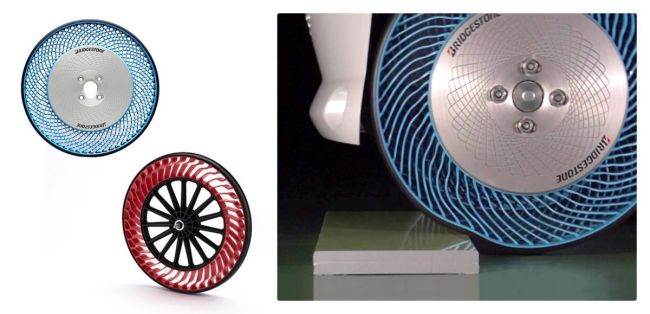
Is the Future of Tires Airless?
Like a lot of technology, airless tires have been two to three years away for the past 15 years. Since 1999, the major tire manufacturers have been developing tires that aren’t inflated with air. At least one of those tires, the Michelin Tweel, has been on the market for some off-road and construction equipment applications.
Ultimately, the goal of an airless tire is to remove the possibility of a flat tire. The common solution right now is a tire-wheel assembly that uses flexible spokes made of rubber and reinforced polyester resin to carry the load of the vehicle to the hub. The outer ring is capped with a rubber tread that can be replaced. The whole tire can be recycled at the end of its life. The airless tire replaces the traditional pneumatic tire and wheel assembly and can be bolted onto existing hubs.
So far, the main difficulty has been engineering a tire that can bear the load of a commercial vehicle and provide grip and durability at highway speeds. That’s why the first commercial offerings were for low-speed, off-road uses.
Michelin has brought its Tweel to market in 10- to 24-inch sizes for commercial lawn mowers, light construction equipment like skid steers, and other off-highway equipment. The tread on the Tweel will last up to three times as long as a pneumatic tire and can be retreaded multiple times.
The U.S. Army tested the Tweel on light tactical all-terrain vehicles during an encampment in the Amazon rainforest. The Army’s engineers valued puncture survivability because the airless tires can keep going for potentially hundreds of miles when compromised. Additionally, units wouldn’t have to carry spare tires, lightening the equipment load.
Michelin has also announced a program with General Motors to offer the Uptis, an updated Tweel design, on GM passenger vehicles in 2024. The air-free tires are being tested on electric vehicles like the MINI and Chevrolet Bolt.
“The vehicles and fleets of tomorrow – whether autonomous, all-electric, shared service or other applications – will demand near-zero maintenance from the tire to maximize their operating capabilities,” said Eric Vinesse, Michelin’s executive vice president, research and development, at the announcement of the GM partnership.
Future Plans
Bridgestone expects to commercialize its advanced air-free concept tire for commercial trucking within the next five years, according to Jon Kimpel, vice president of extended mobility solutions. The company is testing prototypes over hundreds of thousands of miles with specific customers to validate the engineering design and endurance of the concept.
“While air-free tires for passenger vehicles will come to the market eventually, we see more immediate value in bringing this solution to commercial fleets seeking better uptime, sustainability and driver safety,” he said.
The utility and vocational fleet environments are particularly demanding, Kimpel noted. “Any application that has high tire consumption from demanding road conditions and higher operating costs due to punctures and low tire pressure could benefit greatly from the enhanced durability and retreadability of air-free tires,” he said.
Goodyear has tested its airless tires on a Tesla Model 3, with positive results. And there’s a pilot test of the airless tires on driverless grocery delivery robots.
Pros and Cons
Manufacturers expect air-free tires to last longer than conventional tires inflated with high-pressure air. There won’t be a need to repair flat tires or monitor a tire with a slow leak. The airless tires are designed to be retreadable, helping to make them a more sustainable tire solution. Longer service life and the recyclable properties add to the sustainability benefits compared to rubber tires.
However, air-free tires will likely cost more and be heavier than standard tires. The tradeoffs may be worth it for fleets that measure total cost of ownership; there are significant savings to be had from less maintenance and downtime plus the ability to retread repeatedly.
The regulatory barriers may be as challenging as the engineering hurdles. For example, current regulations require manufacturers to note the recommended air pressure on the tire sidewall. With airless tires, that’s a moot point. Commercial launch of highway-capable airless tires may have to wait until the regulatory environment catches up with the technology.
About the Author: Gary L. Wollenhaupt is a Phoenix-based freelance writer who covers the transportation, energy and technology sectors for a variety of publications and companies.

